Reconfigurable Coplanar Waveguide (CPW) and Half-Mode Substrate Integrated Waveguide (HMSIW) Band-Stop Filters Using a Varactor-Loaded Metamaterial-Inspired Open Resonator
Abstract
:1. Introduction
2. Tunable CPW and HMSIW VLORR-Band-Stop Filters: Analysis and Design
2.1. Tunable CPW and HMSIW VLORR-Band-Stop Filters: Structures and Equivalent Circuit Models
2.2. CPW and HMSIW Band-Stop Filters Using ORR
2.3. Tunable CPW and HMSIW Band-Stop Filters Using VLORR
3. Fabrication and Results
4. Conclusions
Acknowledgments
Author Contributions
Conflicts of Interest
References
- Boria, V.E.; Gimeno, B. Waveguide filters for satellites. IEEE Microw. Mag. 2007, 8, 60–70. [Google Scholar] [CrossRef]
- Cameron, R.J.; Kudsia, C.M.; Mansour, R.R. Microwave Filters for Communication Systems: Fundamentals, Design, and Applications; Wiley: Hoboken, NJ, USA, 2007; pp. 1–81. ISBN 978-0-471-45022-1. [Google Scholar]
- Reines, I.; Park, S.J.; Rebeiz, G. Compact low-loss tunable X-band bandstop filter with miniature RF-MEMS switches. IEEE Trans. Microw. Theory Tech. 2010, 58, 1887–1895. [Google Scholar] [CrossRef]
- Gil, M.; Damm, C.; Giere, A.; Sazegar, M.; Bonache, J.; Jakoby, R.; Martín, F. Electrically tunable split-ring resonators at microwave frequencies based on barium-strontium-titanate thick films. Electron. Lett. 2009, 45, 417–418. [Google Scholar] [CrossRef]
- Torrecilla, J.; Urruchi, V.; Sánchez-Pena, J.M.; Bennis, N.; García, A.; Segovia, D. Improving the pass-band return loss in liquid dual-mode bandpass filters by microstrip patch reshaping. Materials 2014, 7, 4524–4535. [Google Scholar] [CrossRef] [PubMed]
- Peng, Y.; Wang, T.; Jiang, W.; Rahman, B.M.F.; Xia, T.; Wang, G. Electrically tunable bandpass filter with patterned permalloy thin-film-enabled engineered substrate. IEEE Trans. Magn. 2015, 51, 2006104. [Google Scholar] [CrossRef]
- Hunter, I.C.; Rhodes, J.D. Electronically tunable microwave bandstop filters. IEEE Trans. Microw. Theory Tech. 1982, 30, 1361–1367. [Google Scholar] [CrossRef]
- Tang, C.W.; Chen, W.C. A compact tunable notch filter with wide constant absolute bandwidth. IEEE Microw. Wirel. Compon. Lett. 2015, 25, 151–153. [Google Scholar] [CrossRef]
- Wang, J.; Ning, H.; Mao, L. A compact reconfigurable bandstop resonator using defected ground structure on coplanar waveguide. IEEE Antennas Wirel. Propag. Lett. 2012, 11, 457–459. [Google Scholar] [CrossRef]
- Hong, J.S.; Lancaster, M.J. Microstrip Filters for RF/Microwave Applications; Wiley: New York, NY, USA, 2001; ISBN 0-471-38877-7. [Google Scholar]
- Pendry, J.B.; Holden, A.J.; Ribbins, D.J.; Stewart, W.J. Magnetism from conductors and enhanced nonlinear phenomena. IEEE Trans. Microw. Theory Tech. 1999, 47, 2075–2084. [Google Scholar] [CrossRef]
- Martel, J.; Marqués, R.; Falcone, F.; Baena, J.D.; Medina, F.; Martín, F.; Sorolla, M. A new LC series element for compact bandpass filter design. IEEE Microw. Wirel. Compon. Lett. 2004, 14, 210–212. [Google Scholar] [CrossRef]
- Vélez, A.; Aznar, F.; Durán-Sindreu, M.; Bonache, J.; Martín, F. Stop-band and band-pass filters in coplanar waveguide technology implemented by means of electrically small metamaterial-inspired open resonators. IET Microw. Antennas Propag. 2010, 4, 712–716. [Google Scholar] [CrossRef]
- Ruiz, J.D.; Hinojosa, J.; Alvarez-Melcon, A. Microstrip notch filters based on open interconnected split ring resonators (OISRRs). Appl. Phys. A 2013, 112, 263–267. [Google Scholar] [CrossRef]
- Ruiz, J.D.; Hinojosa, J. Shunt series LC circuit for compact coplanar waveguide notch filter design. IET Microw. Antennas Propag. 2014, 8, 125–129. [Google Scholar] [CrossRef]
- Baena, J.D.; Bonache, J.; Martín, F.; Marqués-Sillero, R.; Falcone, F.; Lopetegui, T.; Laso, M.A.G.; García-García, J.; Gil, I.; Portillo, M.F.; et al. Equivalent-circuit models for split-ring resonator and complementary split-ring resonators coupled to planar transmission lines. IEEE Trans. Microw. Theory Tech. 2005, 53, 1451–1461. [Google Scholar] [CrossRef]
- Vélez, A.; Aznar, F.; Bonache, J.; Velázquez-Ahumada, M.C.; Martel, J.; Martín, F. Open complementary split ring resonators (OCSRRs) and their application to wideband CPW band pass filters. IEEE Microw. Wirel. Compon. Lett. 2009, 19, 197–199. [Google Scholar] [CrossRef]
- Zhang, Y.; Hong, W.; Yu, C.; Kuai, Z.Q.; Don, Y.D.; Zhou, J.Y. Planar ultrawideband antennas with multiple notched bands based on etched slots on the patch and/or split ring resonators on the feed line. IEEE Trans. Antennas Propag. 2008, 56, 3063–3068. [Google Scholar] [CrossRef]
- Nahsvarian-Jahromi, M.; Tayarani, M. Defected ground structure band-stop filter by semicomplementary split ring resonators. IET Microw. Antennas Propag. 2011, 5, 1386–1391. [Google Scholar] [CrossRef]
- Zhang, S.; Xiao, J.K.; Li, Y. Novel microstrip band-stop filters based on complementary split ring resonators. Microw. J. 2006, 49, 100–112. [Google Scholar]
- Ebrahimi, A.; Withayachummankul, W.; Al-Sarawi, S.F.; Abbott, D. Compact second-order bandstop filter based on dual-mode complementary split-ring resonator. IEEE Microw. Wirel. Compon. Lett. 2016, 26, 571–573. [Google Scholar] [CrossRef]
- Hinojosa, J.; Saura-Ródenas, A.; Alvarez-Melcon, A.; Martínez-Viviente, F.L. Electronically tunable microstrip bandstop filters using a varactor-loaded open ring resonator (VLORR). Appl. Phys. A 2017, 123, 477–482. [Google Scholar] [CrossRef]
- Safwat, A.M.E.; Podevin, F.; Ferrari, P.; Vilcot, A. Tunable bandstop defected ground structure resonator using reconfigurable dumbbell-shaped coplanar waveguide. IEEE Trans. Microw. Theory Tech. 2006, 54, 3559–3564. [Google Scholar] [CrossRef]
- Xiang, Q.; Feng, Q.; Huang, X. Tunable bandstop filter based on split ring resonators loaded coplanar waveguide. Appl. Comput. Electromagn. Soc. J. 2013, 28, 591–596. [Google Scholar]
- Horestani, A.K.; Shaterian, Z.; Naqui, J.; Martin, F.; Fumeaux, C. Reconfigurable and tunable S-shaped split ring resonators and application in band-notched UWB antennas. IEEE Trans. Antennas Propag. 2016, 64, 68–70. [Google Scholar] [CrossRef]
- Jiang, H.; Lacroix, B.; Papapolymerou, J. Compact tunable UHF bandstop resonator filter using varcator-loaded CPW bottom-side meander line. In Proceedings of the 2011 European Microwave Integrated Circuits Conference (EuMIC), Manchester, UK, 10–11 October 2011; pp. 502–505. [Google Scholar]
- Vélez, A.; Aznar, F.; Durán-Sindreu, M.; Bonache, J.; Martín, F. Tunable coplanar waveguide band-stop and band-pass filters based on open complementary split ring resonators. IET Microw. Antennas Propag. 2011, 5, 277–281. [Google Scholar] [CrossRef]
- Cariou, M.; Cadiou, S.; Potelon, B.; Quendo, C.; Ségalen, R.; Mahé, F. New tunable substrate integrated waveguide bandstop resonator. In Proceedings of the 2016 IEEE MTT-S Latin America Microwave Conference (LAMC), Puerto Vallarta, Mexico, 12–14 December 2016; pp. 1–3. [Google Scholar] [CrossRef]
- Esmaeili, M.; Bornemann, J. Novel tunable bandstop resonators in SIW technology and their application to a dual-bandstop filter with one tunable stopband. IEEE Microw. Wirel. Compon. Lett. 2017, 27, 40–42. [Google Scholar] [CrossRef]
- Farzami, F.; Norooziarab, M. Experimental realization of tunable transmission lines based on single-layer SIWs loaded by embedded SRRs. IEEE Trans. Microw. Theory Tech. 2013, 61, 2848–2857. [Google Scholar] [CrossRef]
- Kim, J.; Cho, C.S.; Lee, J.W. CPW bandstop filter using slot-type SRRs. Electron. Lett. 2005, 41, 1333–1334. [Google Scholar] [CrossRef]
- Uchimura, H.; Takenoshita, T.; Fujii, M. Development of a laminated waveguide. IEEE Trans. Microw. Theory Tech. 2009, 57, 1996–2004. [Google Scholar] [CrossRef]
- Deslandes, D.; Wu, K. Integrated microstrip and rectangular waveguide in planar form. IEEE Microw. Wirel. Compon. Lett. 1998, 46, 2428–2443. [Google Scholar] [CrossRef]
- Xu, F.; Wu, K. Guided-wave and leakage characteristics of substrate integrated waveguide. IEEE Trans. Microw. Theory Tech. 2005, 53, 66–73. [Google Scholar] [CrossRef]
- Hong, W.; Liu, B.; Wang, Y.; Lai, Q.; Tang, H.; Yin, X.X.; Gong, Y.D.; Zhang, Y.; Wu, K. Half mode substrate integrated waveguide: A new guided wave structure for microwave and millimeter wave applications. In Proceedings of the Infrared Millimeter Waves and 14th International Conference on Terahertz Electronics, Shangai, China, 18–22 September 2006. [Google Scholar] [CrossRef]
- Lai, Q.; Fumeaux, C.; Hong, W.; Vahldieck, R. Characterization of the propagation properties of the half-mode substrate integrated waveguide. IEEE Trans. Microw. Theory Tech. 2009, 57, 1996–2004. [Google Scholar] [CrossRef]
- Anand, A.; Liu, Y.; Liu, X. Substrate-integrated octave-tunable combline bandstop filter with surface mount varactors. In Proceedings of the 2014 IEEE International Wireless Symposium (IWS), Xian, China, 24–26 March 2014; pp. 1–4. [Google Scholar] [CrossRef]
- Anand, A.; Liu, X. Capacitively tuned electrical coupling for reconfigurable coaxial cavity banstop filters. In Proceedings of the 2015 IEEE MTT-S International Microwave Symposium (IMS), Phoenix, AZ, USA, 17–22 May 2015; pp. 1–3. [Google Scholar] [CrossRef]
- Dong, Y.D.; Yang, T.; Itoh, T. Substrate integrated waveguide loaded by complementary split-ring resonators and its applications to miniaturized waveguide filters. IEEE Trans. Microw. Theory Tech. 2009, 57, 2211–2223. [Google Scholar] [CrossRef]
- Deng, K.; Guo, Z.; Li, C.; Che, W. A compact planar bandpass filter with wide out-of-band rejection implemented by substrate-integrated waveguide and complementary split-ring resonator. Microw. Opt. Technol. Lett. 2011, 53, 1483–1487. [Google Scholar] [CrossRef]
- Shen, W.; Yin, W.Y.; Sun, X.W. Compact substrate integrated waveguide (SIW) with defected ground structure. IEEE Microw. Wireless. Compon. Lett. 2011, 21, 83–85. [Google Scholar] [CrossRef]
- Dong, Y.; Wu, C.T.M.; Itoh, T. Miniaturised multi-band substrate integrated waveguide filters using complementary split-ring resonators. IET Microw. Antennas Propag. 2012, 6, 611–620. [Google Scholar] [CrossRef]
- Wang, J.; Hong, W.; Tang, H.J.; Zhang, Y.; Dong, Y.D.; Wu, K. UWB bandpass filter with multiple frequency notched bands. In Proceedings of the IEEE MTT-S International Microwave Workshop Series on Art of Miniaturizing RF and Microwave Passive Components, Chengdu, China, 14–15 December 2008. [Google Scholar] [CrossRef]
- Cai, Y.; Qian, Z.; Cao, W.; Zhang, Y.; Yang, L. HMSIW bandstop filter loaded with half complementary split-ring resonator. Electron. Lett. 2015, 51, 632–633. [Google Scholar] [CrossRef]
- Cao, W.; Zhang, Z.; Li, S.; Liu, P. Ka band band-stop filter based on complementary split ring resonator and SIW resonators. In Proceedings of the International Symposium on Antennas, Propagation and EM Theory, Guilin, China, 18–21 October 2016. [Google Scholar] [CrossRef]
- Hinojosa, J.; Rossi, M.; Alvarez-Melcon, A.; Martínez-Viviente, F.L. Half mode substrate integrated waveguide (HMSIW) notch filters using open ring resonators. In Proceedings of the International Congress on Engineered Material Platform for Novel Phenomena (Metamaterials), Marseille, France, 28–31 August 2017. [Google Scholar]
- Grover, F.W. Inductance Calculations: Working Formulas and Tables; Dover: Mineola, NY, USA, 2009. [Google Scholar]
- Hilberg, W. From approximation of exact relations for characteristic impedance. IEEE Trans. Microw. Theory Tech. 1969, 17, 259–265. [Google Scholar] [CrossRef]
- Hammerstad, E.; Jensen, O. Accurate models for microstrip computer-aided design. In Proceedings of the IEEE MTT-S International Microwave Symposium Digest, Washington, DC, USA, 28–30 May 1980. [Google Scholar] [CrossRef]
- Deslandes, D. Design equations for tapered microstrip-to-substrate integrated waveguide transitions. In Proceedings of the IEEE MTT-S International Microwave Symposium Digest, Anaheim, CA, USA, 23–28 May 2010. [Google Scholar] [CrossRef]
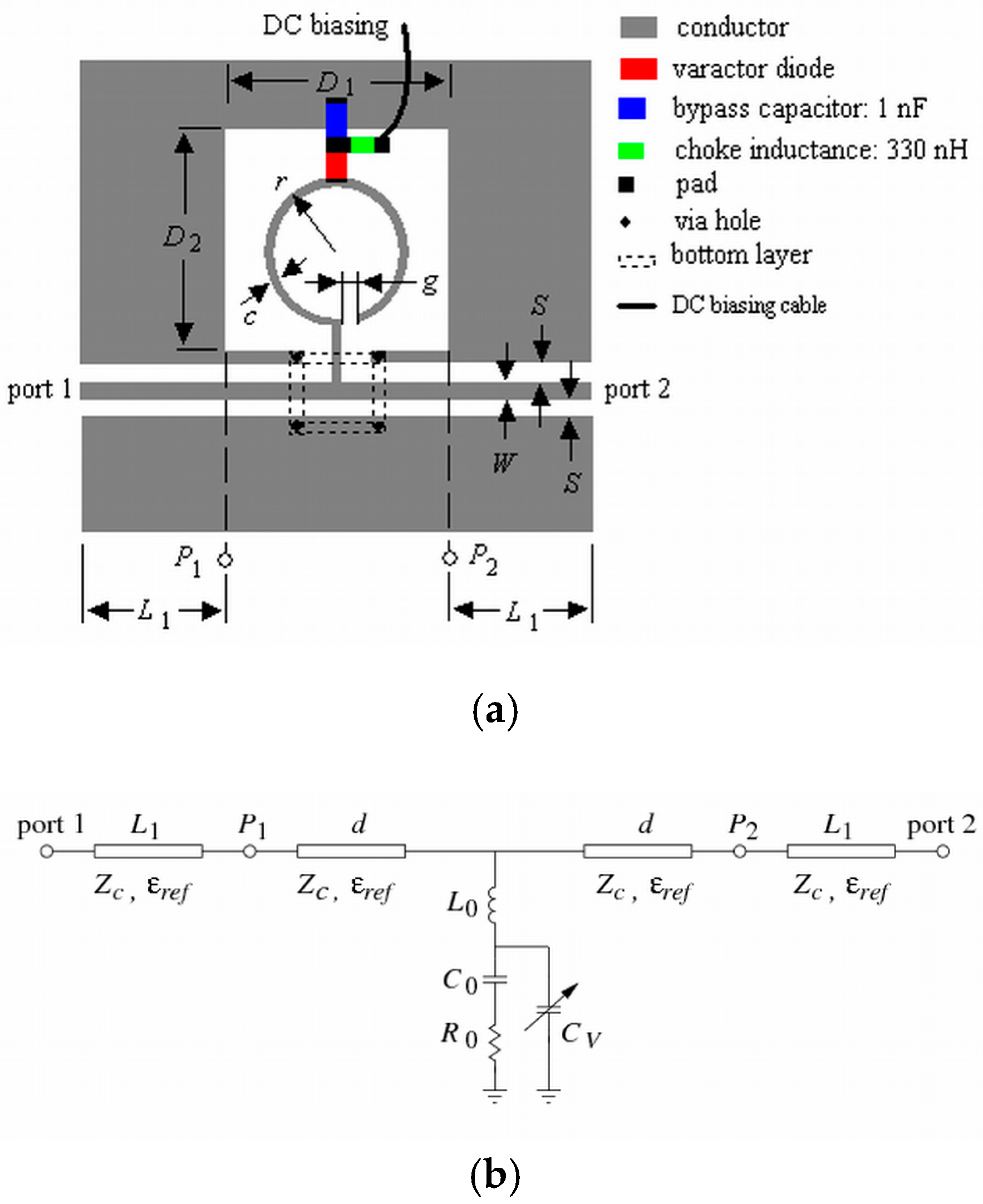
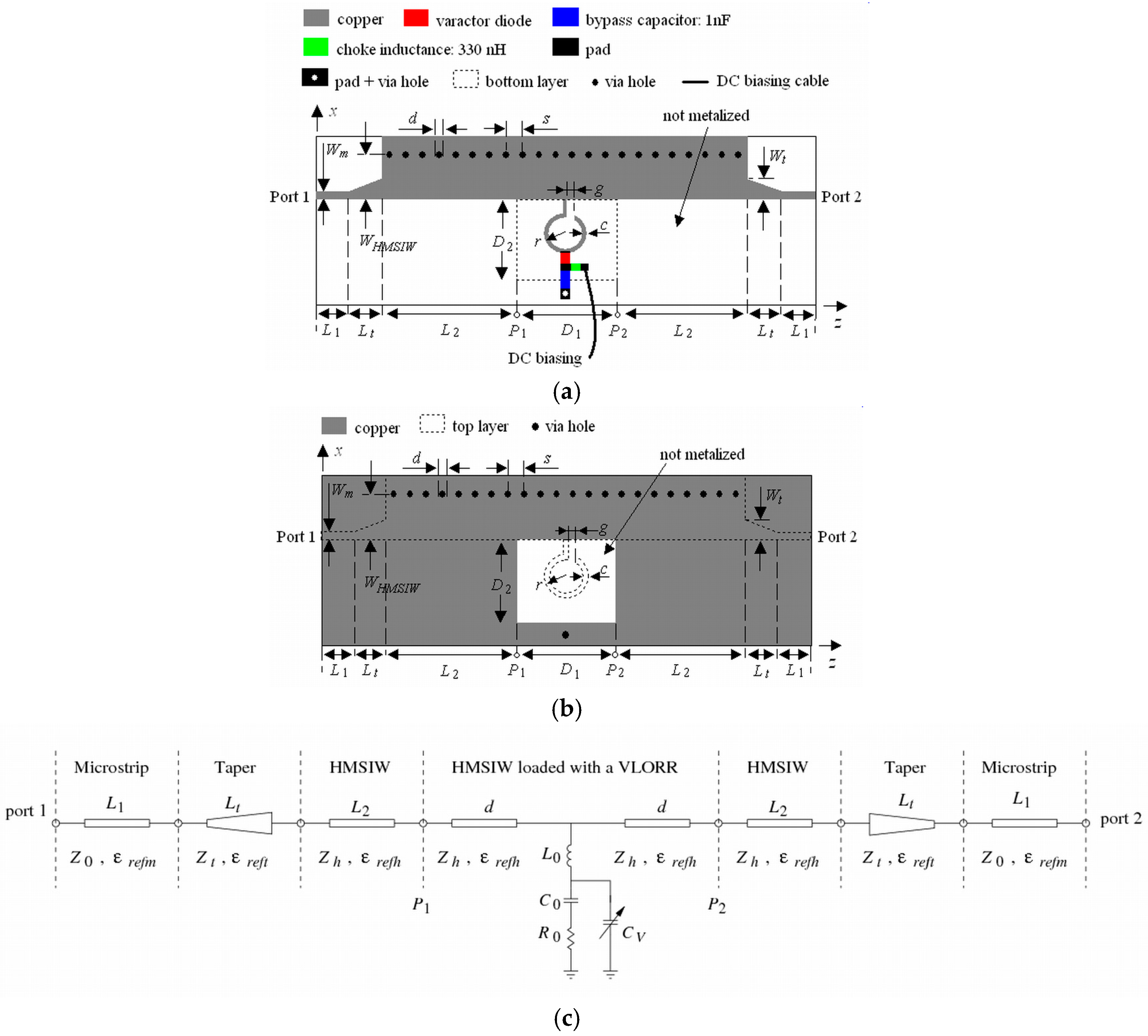
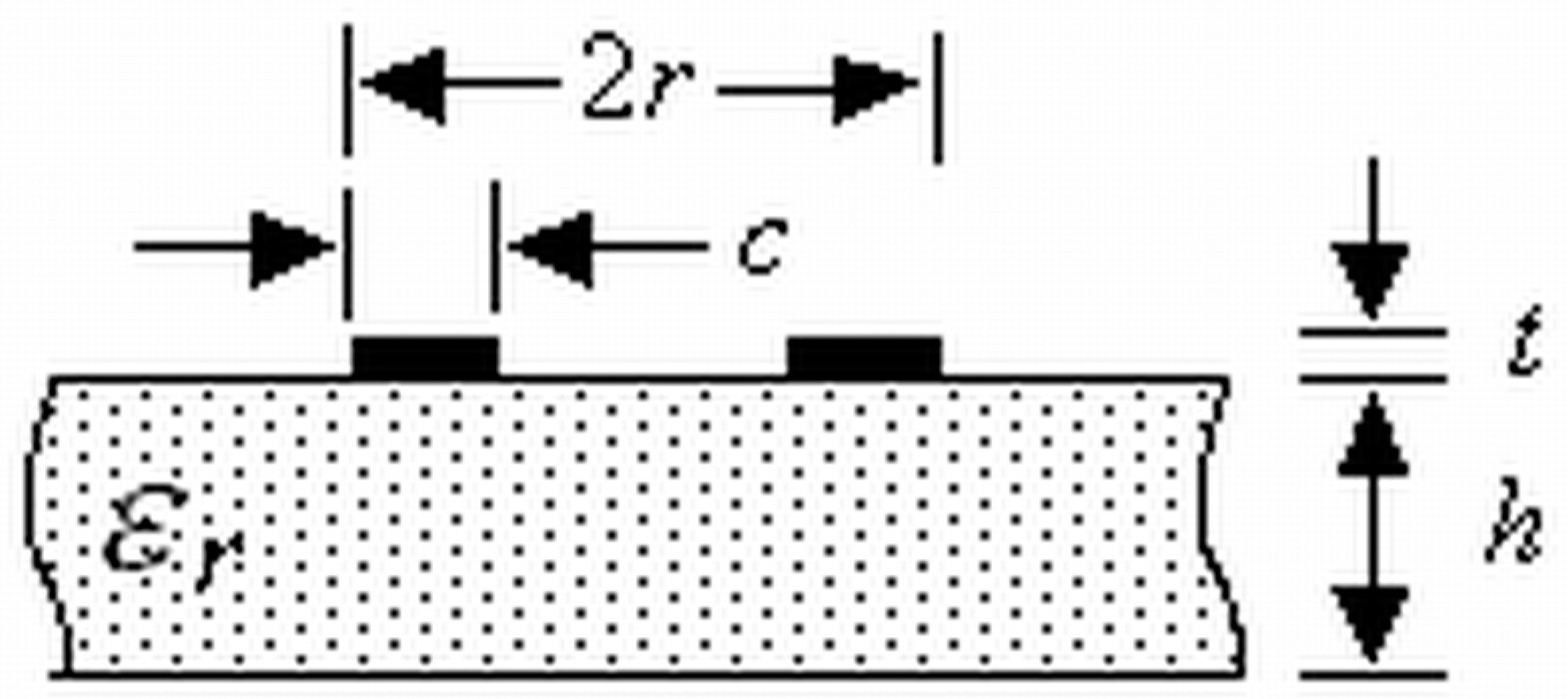
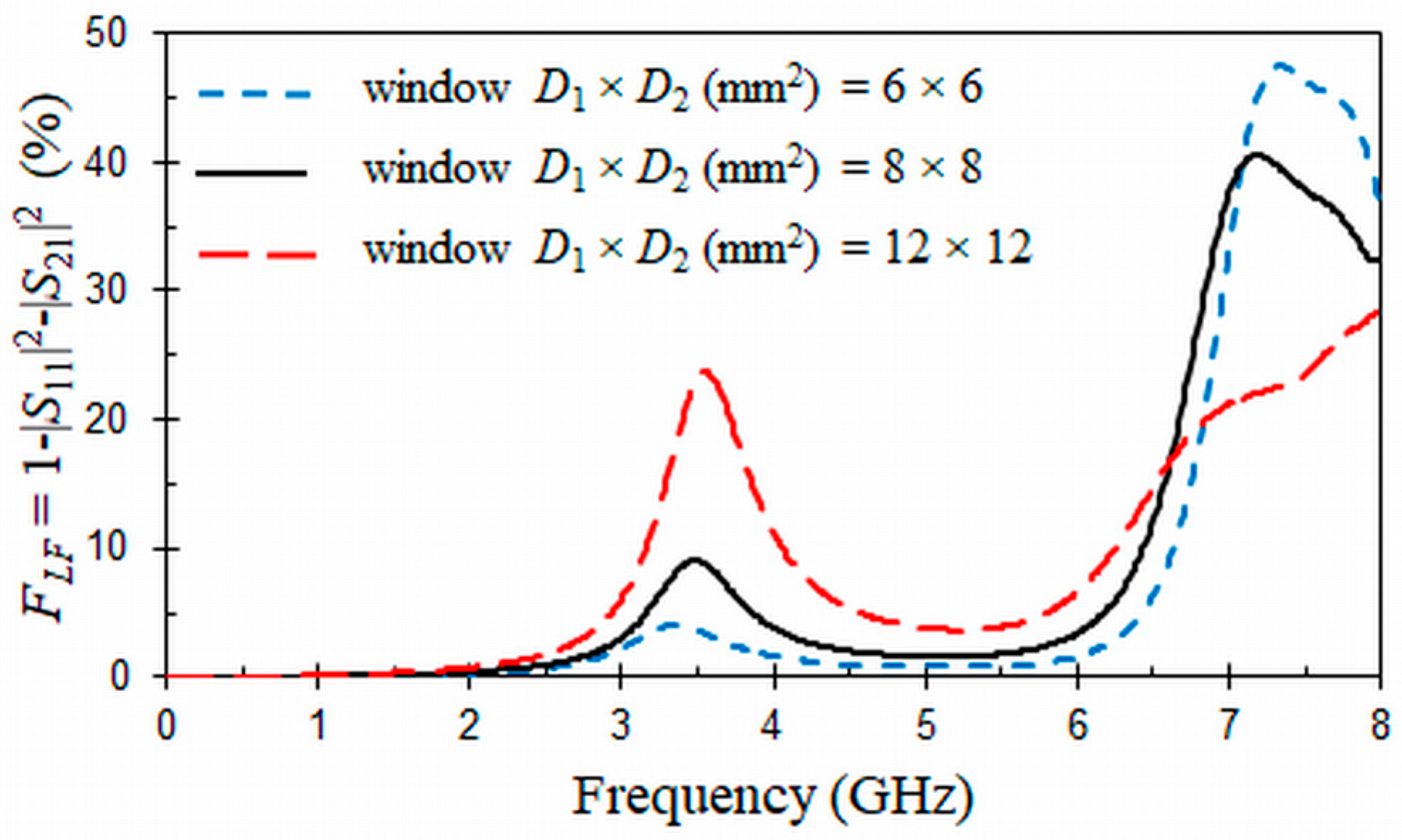
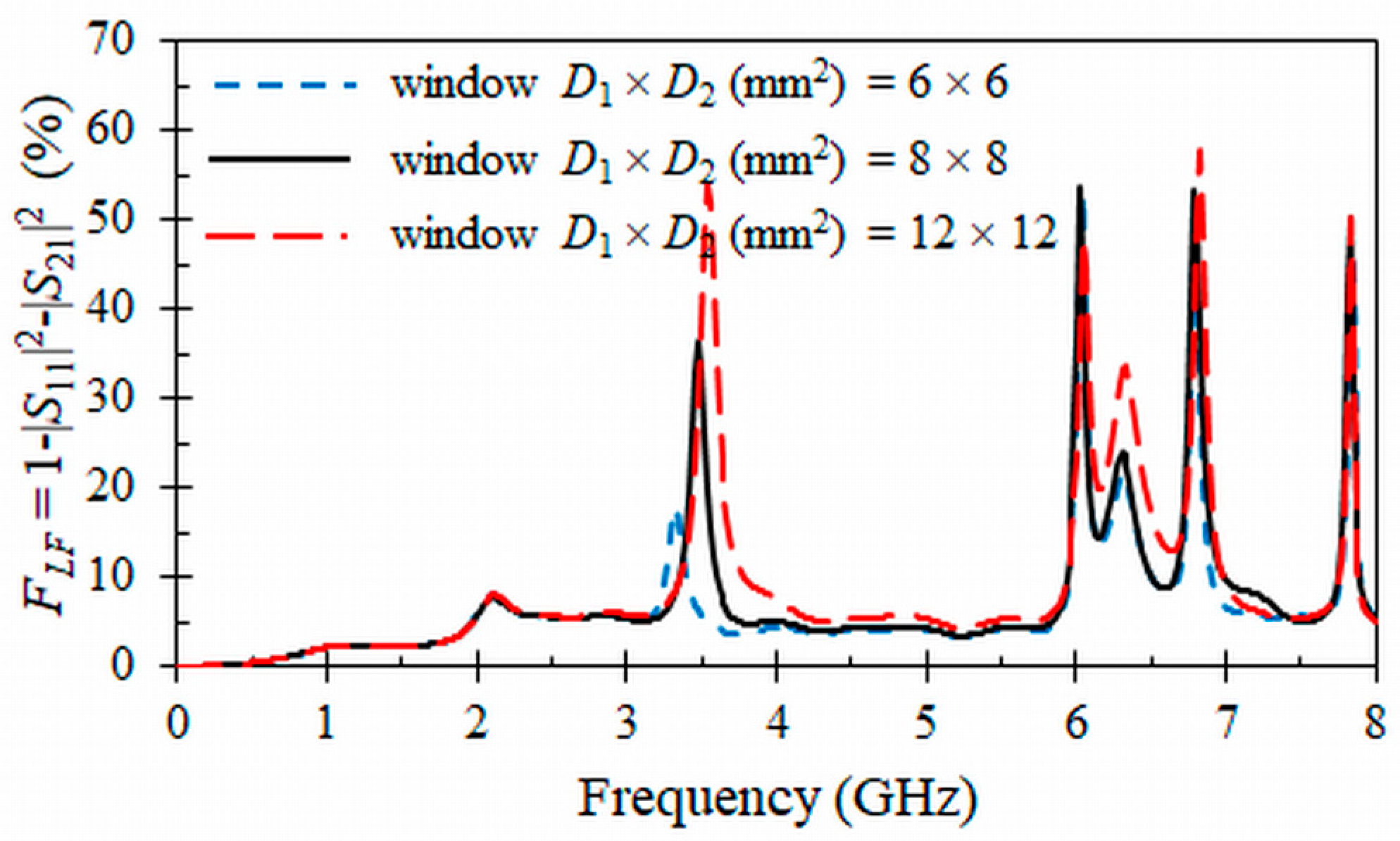


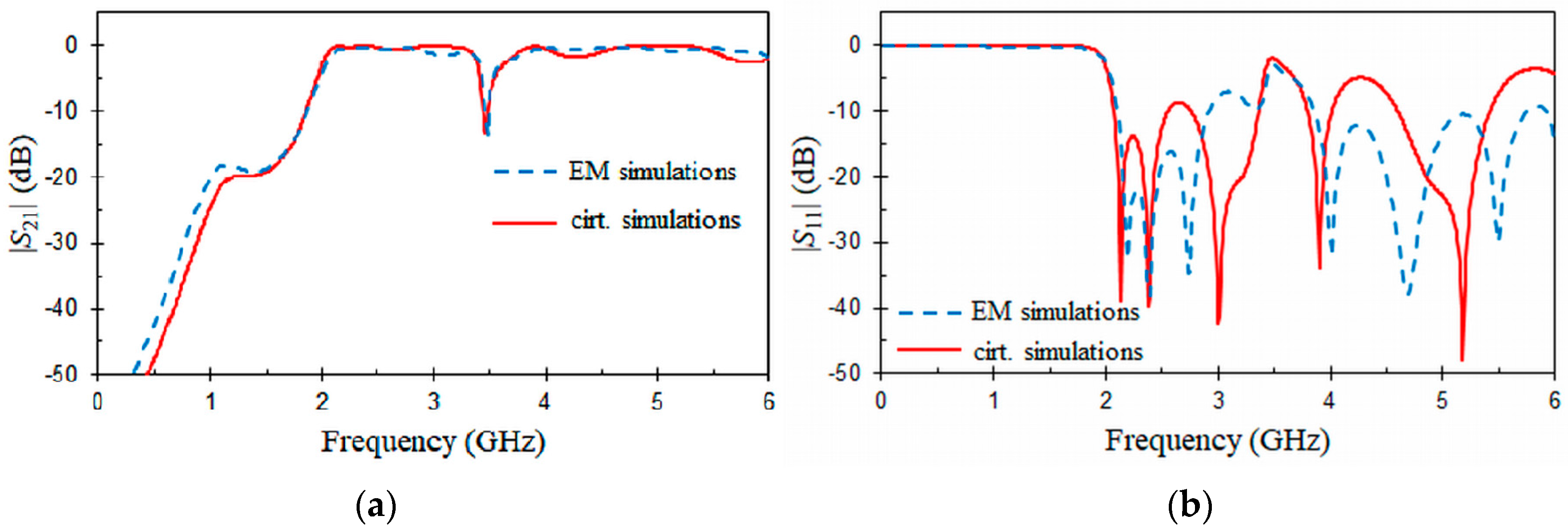
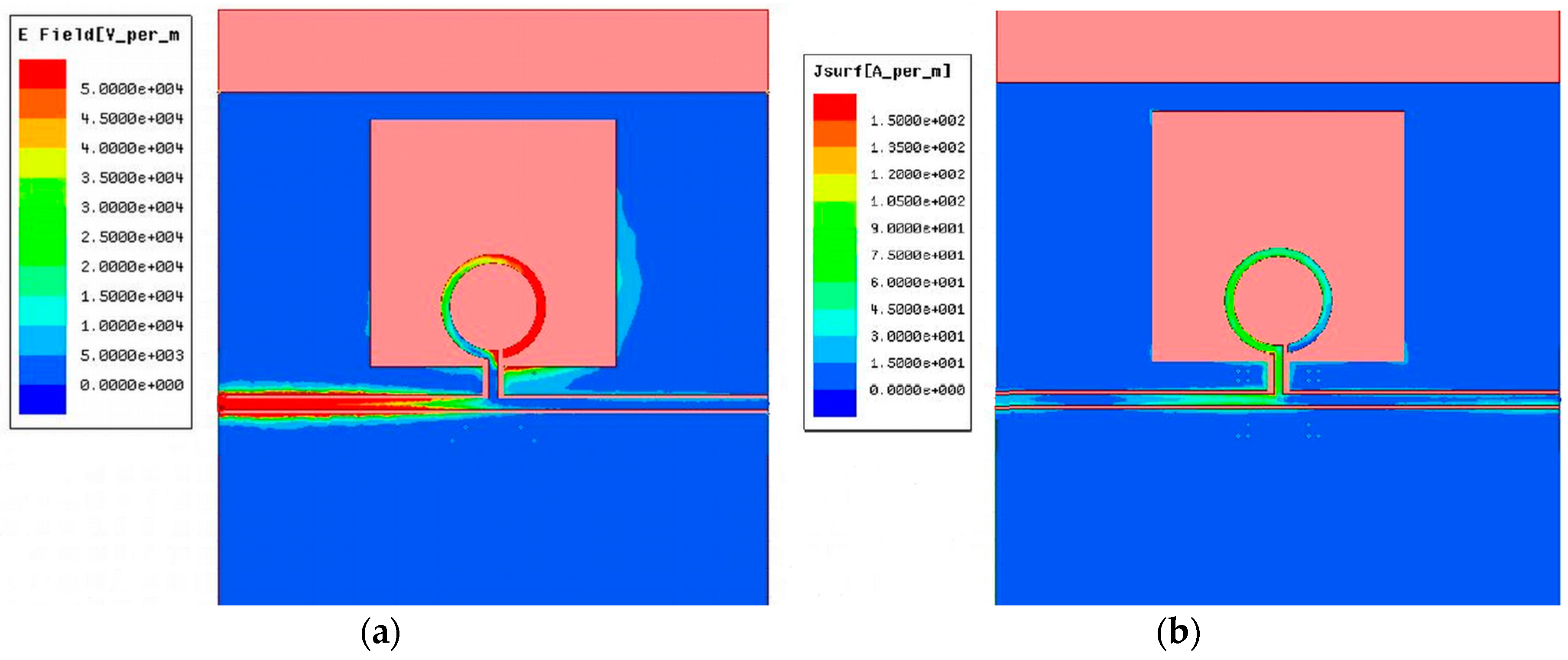
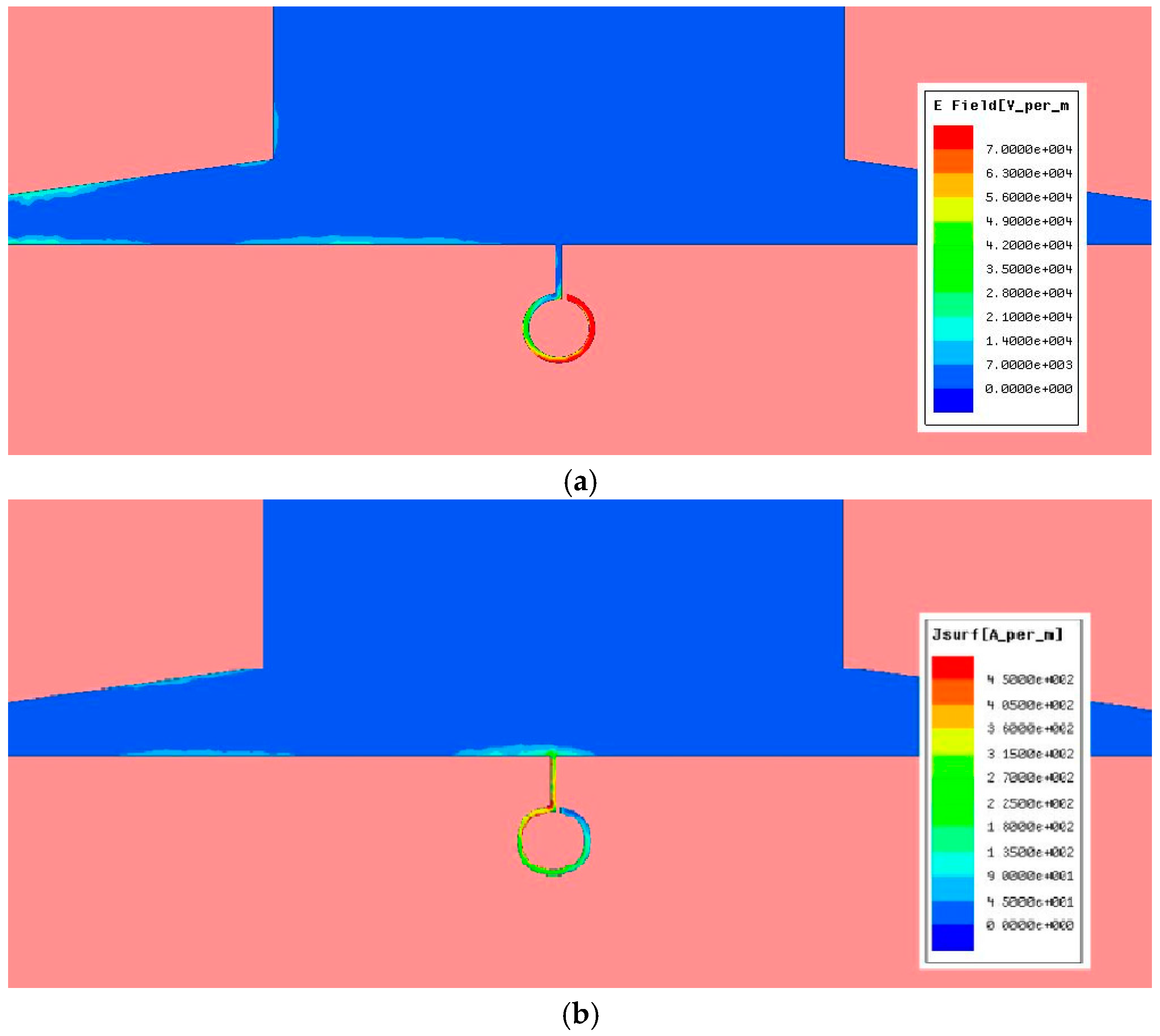



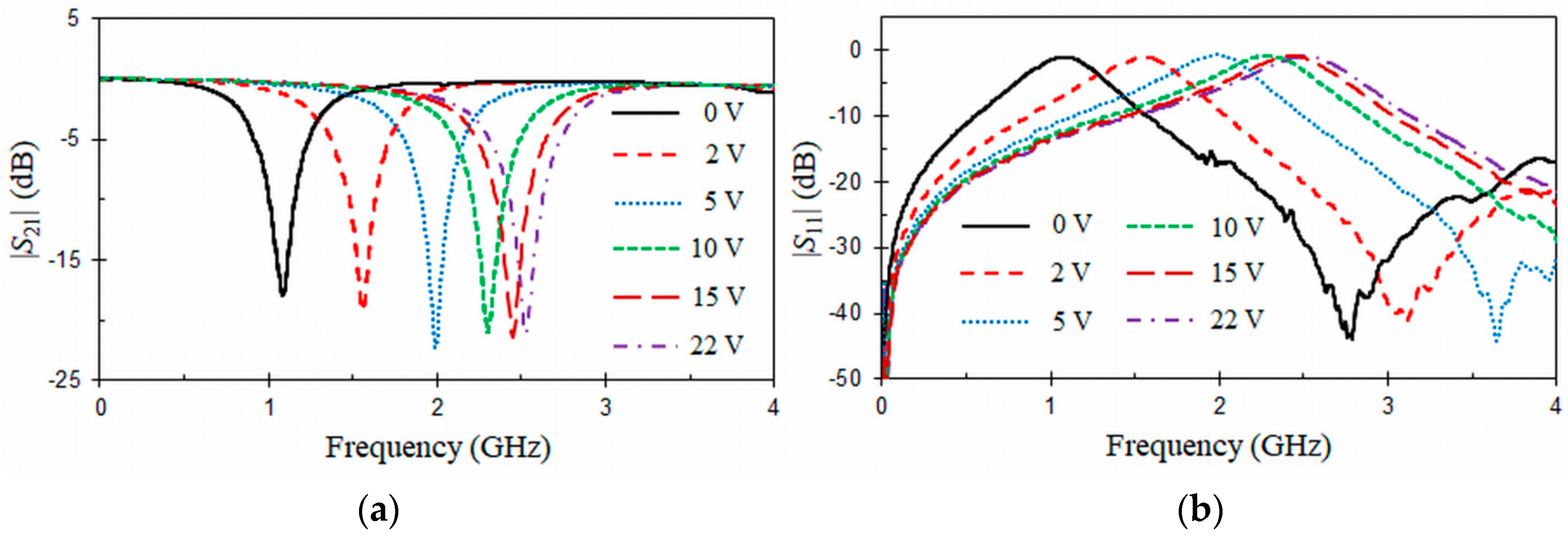
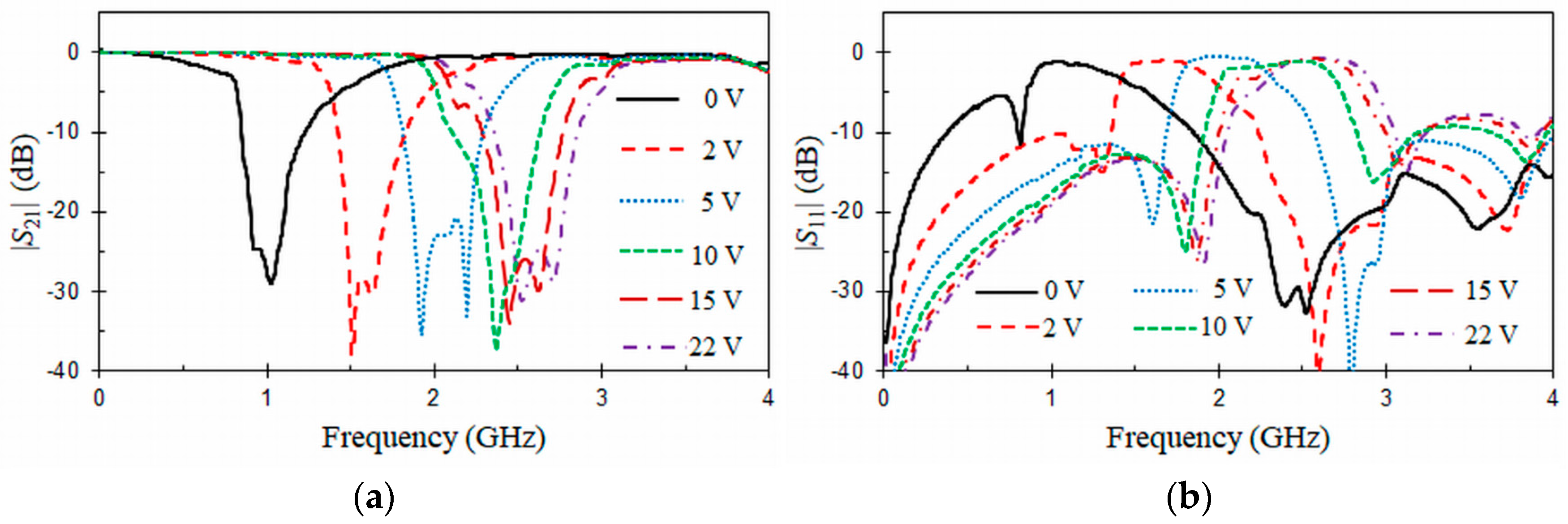
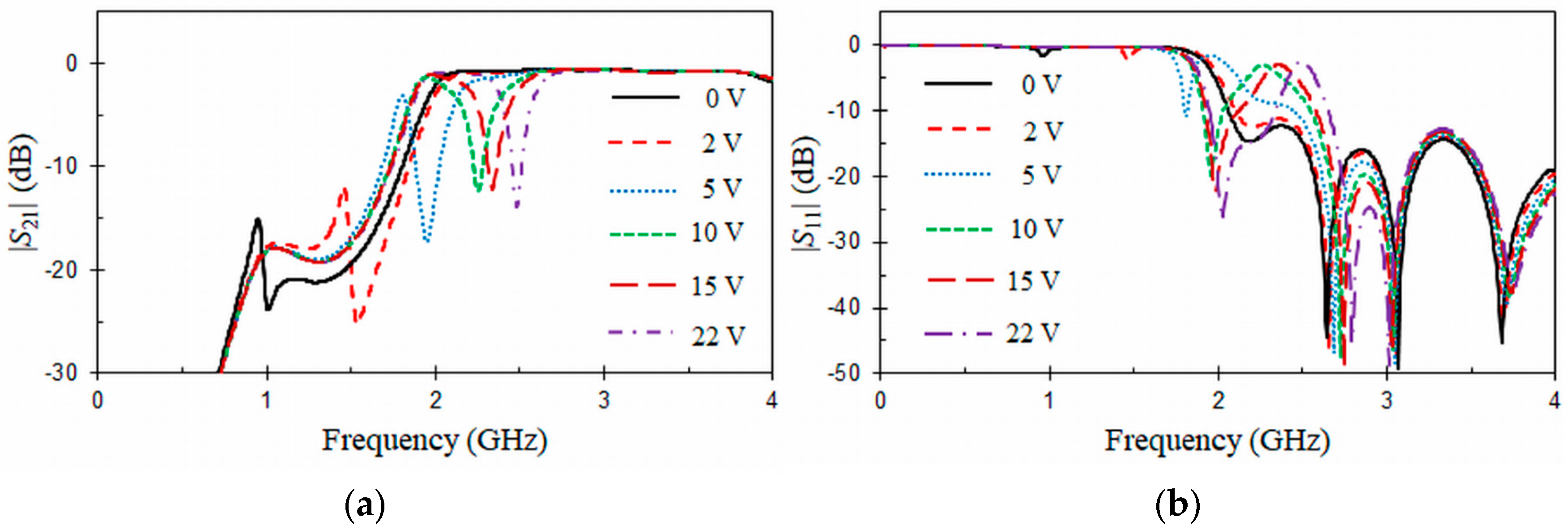
| References | Tuning Range in GHz (%) | No. of Diodes | Absolute BW | 2-D Size |
|---|---|---|---|---|
| [9] Figure 7 | 1.69–2.16 (24.4%) | 2 | Not constant | 0.064 λ0 × 0.16 λ0 |
| [23] Figure 8b | 3.35–4.05 (18.9%) | 2 | Not constant | 0.148 λ0 × 0.074 λ0 |
| [24] Figure 5 | 2.31–2.19 (5.3%) | 4 | Not constant | 0.29 λ0 × 0.375 λ0 |
| [25] Figure 10 | 3.15–3.9 (21.3%) | 3 | Not constant | 0.094 λ0 × 0.071 λ0 |
| [26] Figure 8 | 0.51–1.76 (110.1%) | 2 | Constant | 0.015 λ0 × 0.034 λ0 |
| [27] Figure 3 | 0.6–1.6 (90.9%) | 1 | Constant | 0.021 λ0 × 0.022 λ0 |
| This work Figure 12 | 1–2.53 (86.6%) | 1 | Constant | 0.054 λ0 × 0.054 λ0 |
| Refs. | Tuning Range in GHz (%) | No. of Diodes | Absolute BW | 2-D Size |
|---|---|---|---|---|
| [28] Figure 7a | 10.05–10.26 (2.1%) | 2 | Constant | 0.5 λ0 × 0.5 |
| [29] Figure 3 | 5.32–5.54 (4.1%) | 1 | Constant | 0.083 λ0 × 0.163 λ0 |
| [29] Figure 5 | 3.5–4.1 (15.8%) | 2 | Constant | 0.5 λ0 × not defined |
| [30] Figure 21 | 2.39–4.39 (69.2%) | 5 | Not constant | 0.483 λ0 × 0.011 λ0 |
| [37] Figure 7 | 0.56–1.18 (41.6%) | 64 | Not constant | 0.228 λ0 × 0.059 λ0 |
| [38] Figure 5 | 0.77–1.25 (47.5%) | 8 | Not constant | 0.154 λ0 × 0.101 λ0 |
| This work Figure 13 | 1–2.5 (85.7%) | 1 | Constant | 0.047 λ0 × 0.047 λ0 |
© 2017 by the authors. Licensee MDPI, Basel, Switzerland. This article is an open access article distributed under the terms and conditions of the Creative Commons Attribution (CC BY) license (http://creativecommons.org/licenses/by/4.0/).
Share and Cite
Hinojosa, J.; Saura-Ródenas, A.; Alvarez-Melcon, A.; Martínez-Viviente, F.L. Reconfigurable Coplanar Waveguide (CPW) and Half-Mode Substrate Integrated Waveguide (HMSIW) Band-Stop Filters Using a Varactor-Loaded Metamaterial-Inspired Open Resonator. Materials 2018, 11, 39. https://doi.org/10.3390/ma11010039
Hinojosa J, Saura-Ródenas A, Alvarez-Melcon A, Martínez-Viviente FL. Reconfigurable Coplanar Waveguide (CPW) and Half-Mode Substrate Integrated Waveguide (HMSIW) Band-Stop Filters Using a Varactor-Loaded Metamaterial-Inspired Open Resonator. Materials. 2018; 11(1):39. https://doi.org/10.3390/ma11010039
Chicago/Turabian StyleHinojosa, Juan, Adrián Saura-Ródenas, Alejandro Alvarez-Melcon, and Félix L. Martínez-Viviente. 2018. "Reconfigurable Coplanar Waveguide (CPW) and Half-Mode Substrate Integrated Waveguide (HMSIW) Band-Stop Filters Using a Varactor-Loaded Metamaterial-Inspired Open Resonator" Materials 11, no. 1: 39. https://doi.org/10.3390/ma11010039







